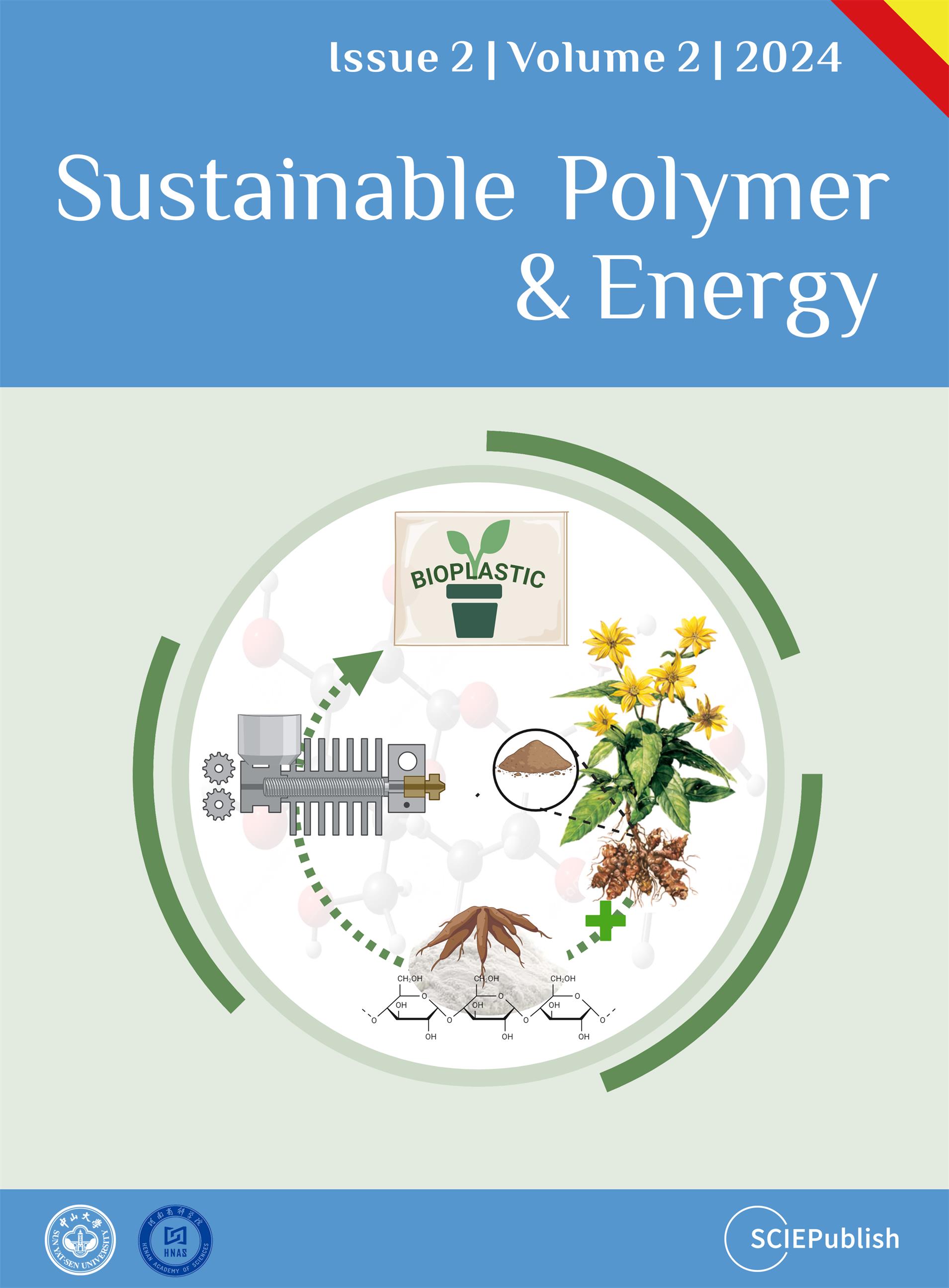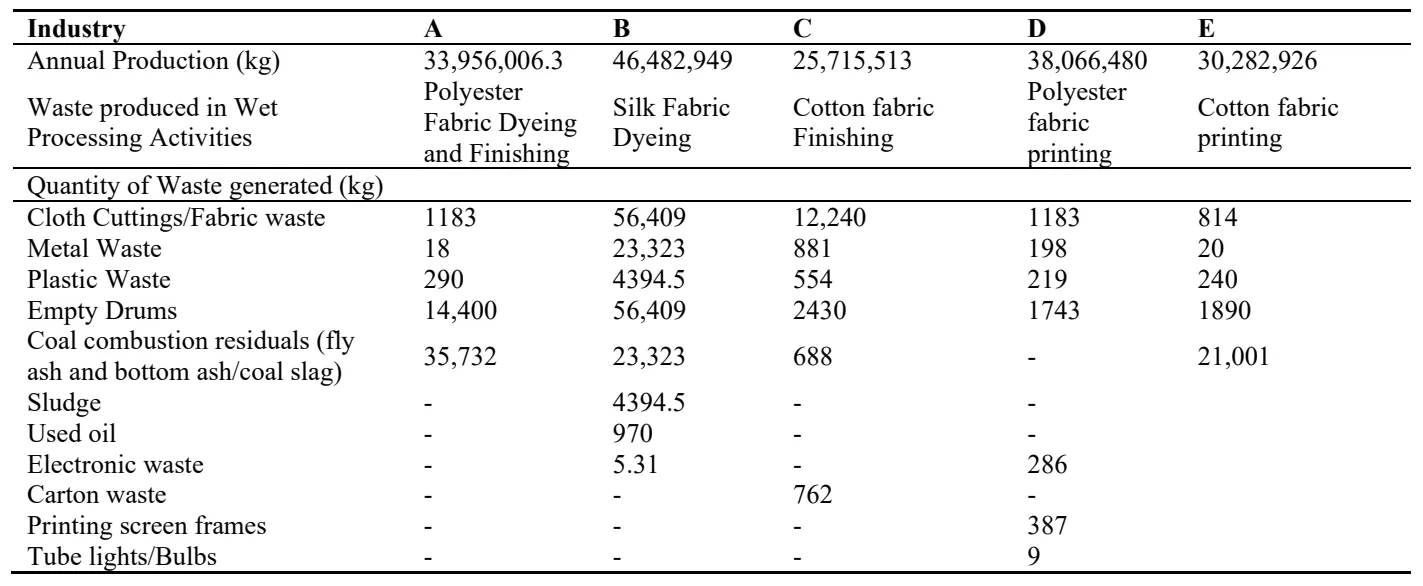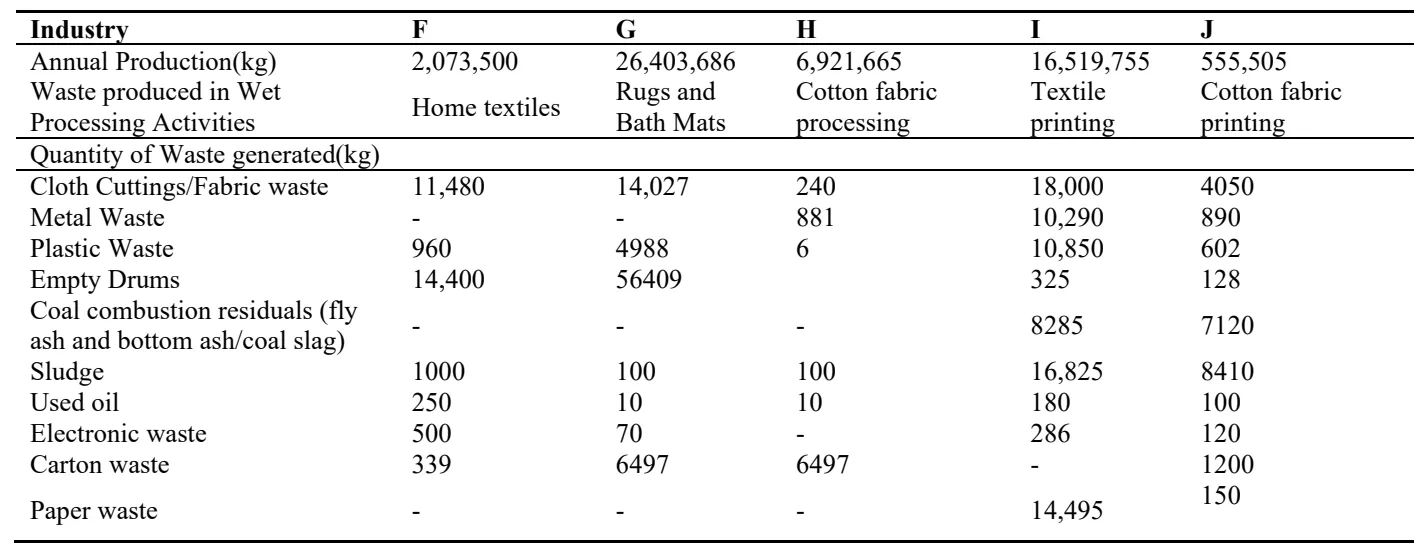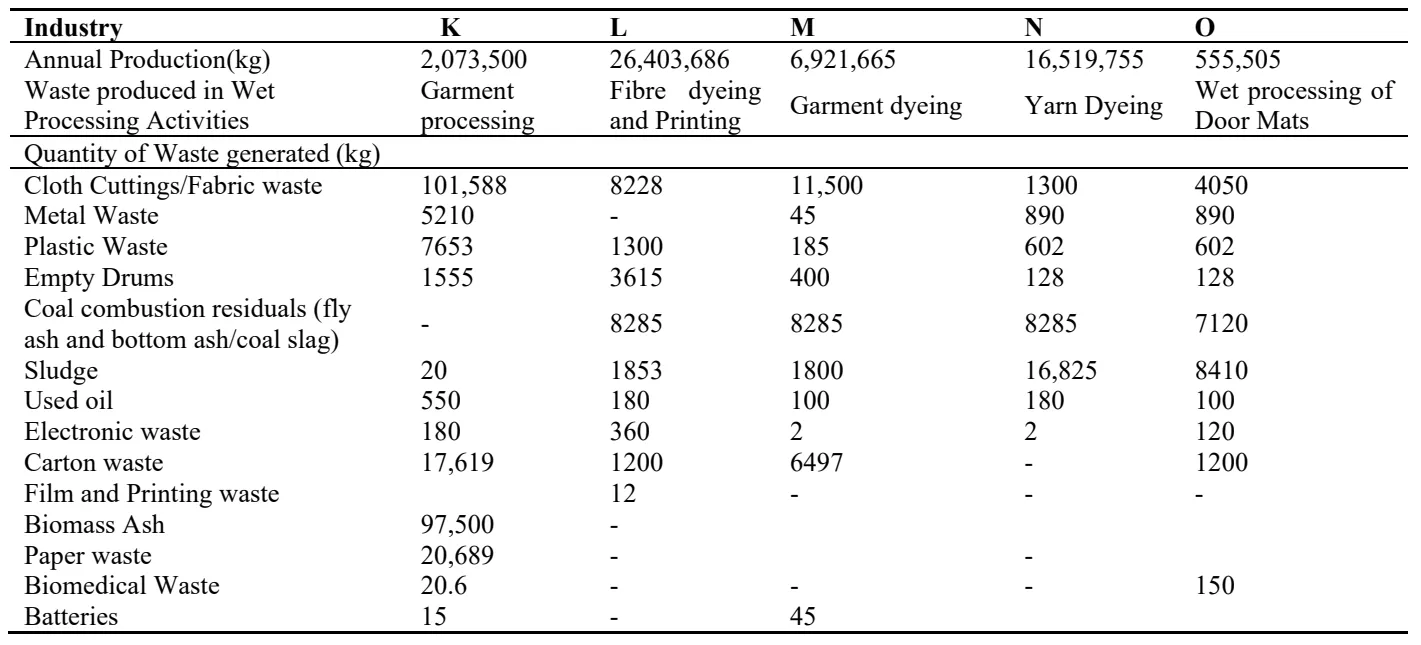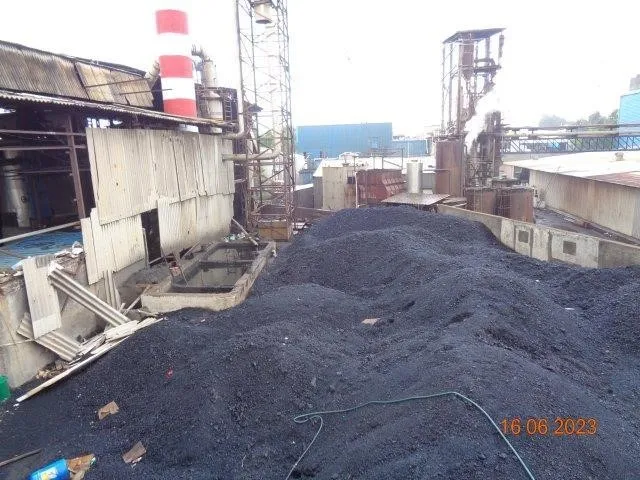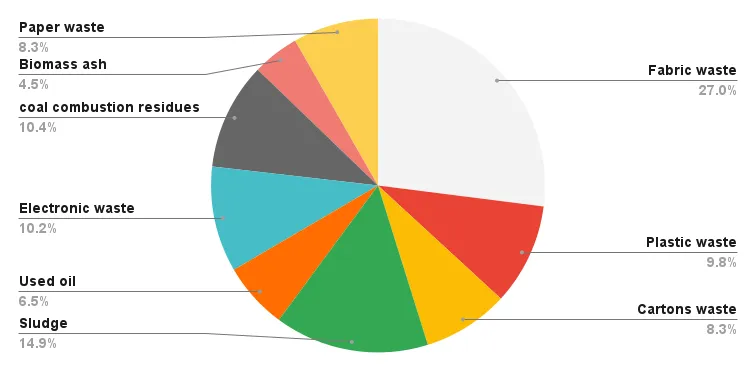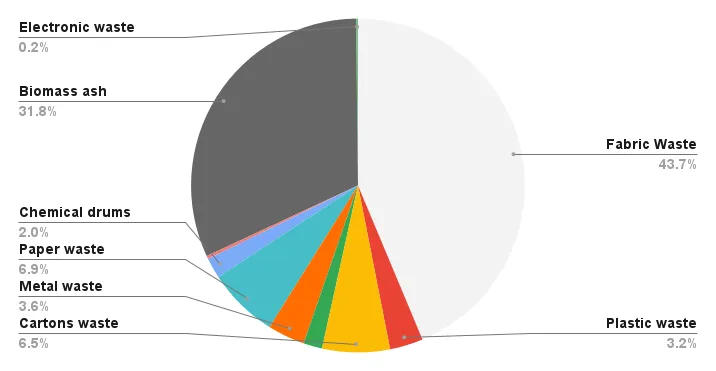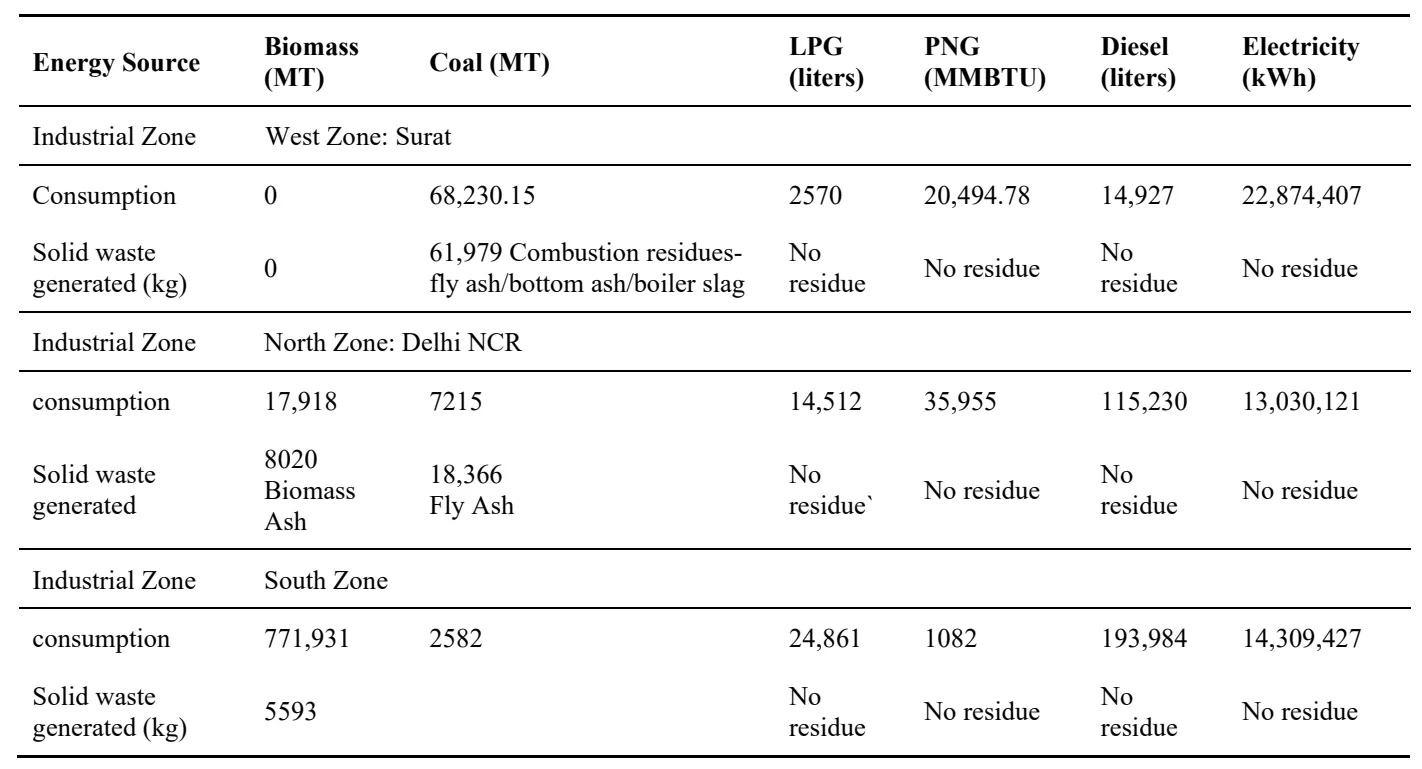Solid Waste Recycling in Textile Processing Industries: A Case Study of India’s Clothing Hubs
Author Information
Other Information
Department of Fibres and Textile Processing Technology, Institute of Chemical Technology Mumbai, Mumbai 400019, India
*
Authors to whom correspondence should be addressed.
Received: 02 May 2024 Revised: 28 May 2024 Accepted: 30 May 2024 Published: 31 May 2024
© 2024 The authors. This is an open access article under the Creative Commons Attribution 4.0 International License (https://creativecommons.org/licenses/by/4.0/).
Sustain. Polym. Energy
2024,
2(2), 10006;
DOI: 10.35534/spe.2024.10006
ABSTRACT:
This study investigated the type and amount of solid waste generation from textile
wet processing industries and analyzed the disposal and recycling strategies
implemented for its utilization. The method involved industrial interactions
with textile processing mills. Data was gathered based on a field survey of
manufacturing units and their compliance management teams. The solid waste
generated in textile processing stages against input raw materials and fuel
sources was recorded. The challenges in recycling solid waste are identified
and further scope for its valorization is suggested. The results indicate that
significant solid waste produced during the wet processing of textiles arises
from waste fabric cuttings, combustion of fuels used in processing stages, and
sludge generated from the post-effluent treatment. Around 80% of solid waste
generated during the wet processing of textiles can find applications in the
construction industry. Effective management of solid waste and its potential
applications in construction are elaborated in detail.
Keywords:
Construction Material; Effluent Incineration; Textile Waste; Reinforced Concrete;
Sludge Landfilling
1. Introduction
Textile materials are among the basic necessities of human beings. While textiles can have several applications, about 60% of global textile production occurs primarily for clothing [1]. The average annual consumption of textiles worldwide has increased from 7 to 13 kg per person, crossing the 100 million tons threshold in the last two decades [2]. The textile industry is considered the second largest industrial polluter in the world. Fast fashion is causing negative externalities, especially in low and middle-income countries. Most waste garments end up in the second-hand market of developing economies. Increased consumption due to the fast fashion trend has dumped tons of textile waste in landfills and unregulated settings [3]. Globally, 75% of textile waste ends up in landfills even though it is recyclable [4]. The concerns about waste garments and discarded clothes at the end of the product life cycle are highlighted frequently. The problems arising due to the disposal of waste fabric in landfills and the emissions caused by their incineration are elaborated on in the existing literature. The textile wet processing industry is known for its water-intensive and energy-consuming stages. The processing sequence involves fibre cleaning (pretreatment), dyeing/printing (colouration), and feel modifying (finishing) shown. The pretreatment processes like desizing, scouring, and bleaching are done to remove the impurities present in greige textile substrates [5] Desizing effluents resulting from removing sizes like starch, PVA and CMC from fabrics account for high biological oxygen demand (BOD) [6]. Dyeing effluents are significant polluters and pose a serious threat to the environment because of their alkalinity, limited biodegradability, and persistent colour [7]. Lastly, the finishing stage involves adding functional properties to the fabric like softness, hydrophilicity, water repellency and other perceptive and protective effects [8]. These three prominent stages consume huge volumes of water, chemicals, energy and time [9]. Multiple basic and specialty chemicals are used at each step of textile processing. Therefore, waste generation is inevitable at each stage of processing. There are numerous well-established methods for treating textile effluent or liquid waste, but managing textile solid waste, especially textile sludge, is challenging [10]. Liquid effluent is closely monitored, and stringent regulatory measures are in place for textile wastewater treatment and disposal. However, solid waste generated in the textile industry is disregarded in favour of incineration or landfilling [11]. The majority of synthetic textile-based waste is not biodegradable. When disposed of in landfills, it stays there undecomposed for a prolonged period and contaminates the soil and groundwater systems [12].
The non-biodegradable nature of waste synthetic fabrics and the shortage of landfilling spaces have inspired people involved in the textile value chain to develop sustainable processes and safer disposal techniques. It is reported that inadequate solid waste disposal practices are found in developing countries [13]. Small-scale textile businesses in developing nations typically operate without the necessary resources to properly handle their waste, contributing to pollution and environmental damage [14]. Though concepts of circular economy and closed-loop recycling are frequently quoted as alternatives to conventional open-loop textile waste management, there are certain challenges in scaling them up [15]. In recent times, textile production has shifted towards the global south in countries like India, Bangladesh, China and Vietnam [16].
The solid waste generated in textile processing mills has not been adequately analysed so far. The existing literature lacks information about solid waste generated in dyeing and printing units which are major textile wet processing industries. This case study fills the literature gap by analysing solid waste generated in India's three prominent textile hubs, which are known globally for textile production and exports. The main objective of this study is to estimate the solid waste produced in textile mills based on the input materials and fuel sources. Zone-wise waste generated in wet processing mills across the nation is recorded by industrial visits to major textile hubs of India, namely Surat (West), Delhi NCR (North) and Tirupur (South) textile clusters. The solid waste produced in the processing mills in these three zones of India is studied and the recycling strategies used for generated waste are analysed.
The solid waste generated depends upon the fuel source used, and the waste produced is recorded. The challenges in valorising waste from the textile wet processing industry are identified and strategies for waste recycling and its valorisation in construction and other industries are suggested. Solid wastes arising from the textile industry are categorised as either post-consumer textile wastes (PCTW) or post-industrial (originating from industrial operations) textile wastes [17]. According to previous studies, Post-industrial textile waste refers to cutting waste, quality rejections, and excess fabrics produced during the textile and garment production process [18]. In this study, we have come across other post-industrial solid waste sources in textile processing, which contribute significantly to environmental impact. This study fills the void in the existing literature by providing information about solid waste generation in the textile processing stage and its disposal protocol. It also throws light on the limitations of current disposal and recycling practices. It further highlights applications for disregarded textile solid waste in other industries, especially construction. Textile fibrous waste has great potential to be used as a secondary raw material in the construction and building sector. Several research studies have demonstrated the use of textile fibre waste in construction and geo-technical applications [19]. There are many potential applications for the valorisation of textile solid waste, particularly sludge and fiber waste in construction materials. Sustainable reuse of woven fabric waste for producing thermal insulation building material has been studied [20]. Numerous studies have demonstrated cement replacement by coal combustion residues like fly ash [21]. Another research study reported the use of fly ash for synthesizing novel geo-polymeric membranes, which can be used for textile wastewater treatment [22]. Textile waste-based hybrid composites have higher strength and modulus than wood. Textile waste-based reinforcements are economical and environment friendly [23]. On the other hand, other crucial waste material - fly ash is of tremendous importance in construction industries. Previous studies have shown the scarce use and recycling of fly ash discarded from thermal power plants. Fly ash can be used in cement production, dam injections, and brick manufacturing. Unfortunately, a very small amount of fly ash is being re-utilized in construction applications [24]. Textile processing requires huge amounts of energy, and combustible fuels like coal biomass are a prominent choice. Textile mills, on the consumption of such fuels, are left with combustion residues like biomass ash, fly ash, bottom ash, boiler slag, etc. There is no documentation of such valuable waste produced in the textile industry that can be recycled in construction applications. This case study has evaluated the amount of waste produced in textile processing industries that can find possible applications in the construction industry which is otherwise diverted to landfills.
2. Materials and Methods
For this case study, three textile zones (north, west and south) of India, specializing in wet processing of textiles were investigated by onsite visits and interaction with their management and compliance teams. A field survey of five textile wet processing industries from each zone was carried out and the waste management data from a total of 15 industries was analyzed. To maintain confidentiality, each industry in respective zones is named anonymously in alphabetical order as follows: Five textile processing units located in the west zone (Surat) are named A, B, C, D, and E. The processing mills in the North zone (Delhi NCR region) are labeled as F, G, H, I and J, respectively. Textile manufacturing units in the southern areas of India are named K, L, M, N and O. The field survey of all 15 textile mills was done following the audit protocols mentioned in ISO 14001:2015 standard [25].
Solid Waste Generation in Textile Wet Processing Mills
The main objective of this case study was to investigate the solid waste produced in textile processing industries in pretreatment, dyeing, printing and finishing stages. Table 1 indicates the waste produced in each sector of the respective zone surveyed for this study. The core processing stages carried out in wet processing industries of respective zones, along with their annual production, are indicated in Table 1, Table 2 and Table 3 . The quantity of waste produced is recorded from waste challans and bills issued by the authorised waste handlers. The textile industries are also maintaining waste registers to fill requisite forms of the Pollution Control Board (PCB). The relevant data of recorded waste is taken from these registers as well. Waste generated in facilities (hazardous and non-hazardous) is validated through the waste handler agreement, waste handler site visit report, transaction vouchers, and manifest copies.
As indicated in Table 1, Table 2 and Table 3 there are common categories of solid waste generated in all three zones. Excess cloth cutting, fabric waste, and loose fibres produced as a result of rejects from the quality department are the most prominent categories of solid waste generated in textile wet processing. These fabric waste/cloth cuttings are produced in large quantities in the processing departments of the mills and then thrown away (Figure 1). Other primary sources of solid waste generation are combustible fuels. Wet processes like bleaching fabrics, printing and finishing require extreme temperatures up to boiling (100 °C). Some processes, like polyester dyeing and cotton printing, require steam generation. In India, it is observed that coal is the primary choice for fueling boilers used for steam treatments given to fabrics. Coal combustion residues like fly ash, bottom ash, and boiler slag are other major solid waste components produced in textile wet processing industries (Figure 2).
Plastic waste arises from packed plastic films and incoming raw materials like yarns and greige fabric. Discarded shade cards, dyeing/printing recipe cards, and other stationery contribute to paper waste in the processing units. Waste of machinery spares makes for the metal waste produced in industries. Other solid waste generated in textile industries is from waste tube lights, biomedical waste, empty chemical drums, carboys and waste cartons used in the facility.
Zone-wise Illustration of waste generated in textile processing mills.
Figure 3, Figure 4 and Figure 5 indicate the share of solid waste generated from different sources in the north, West and south zones, respectively. As shown in Figure 3, the major sources of solid waste generation in textile industries are discarded fabrics followed by combustible fuels. Out of the total waste produced by the textile industry, about 27% of solid waste is from fabrics. Ash residues resulting from coal and biomass combustion collectively account for 14.9% of solid waste. The solid sludge resulting from effluent treatment plants at the end of wet processing is another major hazardous waste produced in textile wet processing industries, accounting for 14.9% of total solid waste generated.
The western and southern zone textile processing industries show similar trends in waste produced. Cloth cuttings and fabric waste account for 44.9% and 43.7% of solid waste generated in the west and south zone, respectively. Fly ash produced by the combustion of pulverised coal used in boilers of textile mills adds to 29.1% of total solid waste. In addition to coal, most of the textile mills located in the southern zone of India also use biomass as a fuel source. Like coal, biomass derivatives like briquettes, rice husk and other agro-wastes produce ash residues on burning. This biomass ash accounts for 31.8% of total solid waste generation. The recorded values of sludge in the north and south zones were less than those recorded in the west zone. The documented value of sludge is minimal in the western and southern zones. Thus, the data from all three zones indicates three main categories of solid waste: Cloth cuttings (Fabric waste), Fuel combustion residues (Coal fly ash, biomass ash etc.) and sludge resulting at the end of wet processing. Other waste categories like plastic, paper, electronic and biomedical waste have a negligible share in total waste produced in the textile wet processing industries.
Influence of fuel sources and water consumption on solid waste generation.
The input fuel sources used in processing stages and corresponding waste generated in individual industries are recorded in Table 4. Biomass and coal are measured in metric tons (MT). The tabulated values of LPG and Diesel in Table 2 are measured in litres. PNG and electricity are expressed in Metric Million British Thermal Units (MMBTU) and Kilowatt (KWh) hours, respectively. Except for biomass and coal, all other energy sources are cleaner fuels. LPG, PNG and Diesel burn without producing any residues. So, these cleaner fuels do not contribute much to solid waste generation.
In the west zone, annually, 68,230 metric tons of coal, 2570 litres of liquefied petroleum gas, 20,494 MMBTU Pressurized natural gas (PNG), 14,927 litres of Diesel and 22,874,407 kWh electricity are consumed for fueling textile wet processing operations in the 5 surveyed industries. Among these fuel sources, 68,230 metric tons of coal on combustion produces 61,979 kg of combustion residues. These are mainly boiler slag, fly ash, and bottom ash. On the other hand, in the northern and southern zones, coal is partially substituted by biomass fuel sources. These can be agro-based waste, briquettes, wood pallets and other biomass fuel derivatives. Like coal, on combustion, these biomass-based fuels also produce solid waste, i.e. biomass ash. In the northern and southern zone, biomass ash contributed to the generated total solid waste in addition to coal combustion residues.
The textile wet processing is a highly water-intensive segment. Wastewater emerging at the end of processing is passed through a series of effluent treatment chambers. The solid sludge generated after the effluent treatment sequence is proportional to the input water required for processing. Table 5 depicts the amount of wastewater consumed in textile wet processing annually in all three zones. Textile processing factories rely mainly on municipal supply of water for production activities. In addition to municipal freshwater supply, groundwater reserves are utilised to meet the water consumption needs of textile mills. Treated wastewater from a common effluent treatment plant (CETP) is utilized again in processes where water quality is not required. Solid sludge arising after consuming such hefty volumes of fresh water is another concern for disposal. Textile sludge constitutes a high concentration of heavy metal elements. Thus, landfilling sludge is detrimental to the environment. Landfilling is the primary method of disposing of textile sludge at the moment [26].
3. Results & Discussion
The detailed survey of 15 textile processing industries of three major textile hubs in India gave the following results. Postindustrial textile solid waste is generated in three major forms: 1. Cloth cuttings, 2. Fuel Combustion residues (fly ash, bottom ash, boiler slag, biomass ash) 3. Sludge. The noteworthy point is that all these three major solid waste forms find applications in the construction industry.
The solid sludge produced is proportional to the input water consumed in processing. About 70% of textile processing solid waste has potential applications in the construction industry. However, most of it is getting downcycled and ultimately lying in landfills.
From the observations of this case study, it can be inferred that there are certain limitations in the current waste management and recycling strategies of post-industrial textile solid waste generated in textile wet processing industries. The commonly observed industrial practices implemented in all three zones to recycle textile waste are discussed here.
Chemical carboys and empty chemical drums are sent back to suppliers for refilling. Paper waste and metal waste are handed over to authorised scrap dealers. It is recycled in a closed loop. Used oil is reutilized for lubrication of machinery. Tube lights and fused bulbs are being landfilled. Contaminated printing screens and cartridges are either incinerated or landfilled. Waste batteries are given to suppliers as per buyback policies. The treated solid sludge produced from wet processing effluents emerging from dyeing, printing and finishing operations is supplied to cement manufacturing companies. As per solid waste management rules 2016, textile industries must divert the sludge from landfilling [27].
Most textile processors are giving away the sludge to combine with concrete for construction applications. While some cloth cuttings are given to authorised fabric recyclers, some fabric waste is handed over to rag pickers who forward the waste fabric cuttings and loose fibres to fabric down cyclers. These down cyclers use the cloth cuttings for making carpets, bath mats, floor dhurries etc. The loophole here is that these downcycled products, after living a certain longer lifespan, ultimately end up in landfills or else incinerated. Thus, down-cycling fabric waste is ineffective for postindustrial textile solid waste management.
Unlike sludge, mills' fabric cuttings and loose fibre waste do not have a regulatory mandate for recycling. It's a government mandate for textile processing mills to divert their solid sludge from landfills and give it to brick manufacturers or cement industries. Since cloth cuttings fall under the non-hazardous category of solid waste, there is no regulation for generated fabric waste. Fabric trims and textile scraps discarded due to defects are often described as wasted raw materials. It is passed on from rag pickers and scrap collectors to down cycles. After a longer lifespan as a down-cycled product, it ultimately ends up in landfills.
Although it is easy to segregate pre-consumer waste in the industry itself, in small-scale enterprises, there is a lack of monitoring of waste. Some wet processing industries are not even segregating the waste into categories. Providing training and some kind of subsidy to sorters in the facility will be beneficial. Using cleaner fuels does not add to the solid waste as they burn without producing residues. However, most of the textile processing is reliant on combustible fuels like coal. Due to demands to phase out coal in production from brands like Zara and H&M, textile processors have partially substituted coal with biomass. But biomass also produces an ash residue which adds to solid waste. Fabric waste is seen to be dumped with other sorts of waste produced in the industry.
It is encouraging to see some textile wet processors supplying sludge and fly ash to brick manufacturers and cement producers for construction applications like pavement blocks and geo-technical applications. The textile processing industry relies on waste handlers to dispose of the solid waste it generates. Once it is handed over to the waste handlers, there is no track of what happens with the solid waste. Most of the fabric waste is being downcycled to textile products like floor mats, bath mats, etc., which ultimately adds to disposable waste in landfills after a certain time. On the contrary, if the same fabric waste, cloth cuttings, fly ash, and sludge are upcycled to make more durable or permanent products like reinforcements, bricks, and pavements for the construction industry, it can be considered the most efficient waste management scenario. Textile solid waste management is a global challenge. However, soild textile waste management at production stage becomes crucial in south Asian countries like India, China, Vietnam, Bangladesh which have become textile hubs of these century. Apart from providing knowledge of sorting and seggregation to the factory workers the need for sensor based automation for separating textile waste depending on types of fibres and blends will also be beneficial. The industrial practise is to handover the industrial textile waste to ragpickers and scrap owners. This supply chain is fragmented and needs to be streamlined. The system is needed to track the transportation of waste in various settings. The perspective towards textile waste also matters. Most of the industries neglect textile waste management because of its non-hazardous characteristics. This neglience is ultimately seen piling up in landfills or in the form of carbon emissions when the same fabric waste is incinerated. The textile and fashion industry is infamous for its solid waste generation worlwide. The water and energy intensiveness of the textile industry and the way fast fashion affects solid waste produced worldwide is a hot topic of discussion on various global forums. UNEP has discussed the environmental problems of fast fashion including textile waste in several reports. It has launched United Nations Alliance for Sustainable Fashion to mitigate issues of the textile industry an promote sustainable fashion.To promote the principles of circular economy, the Ellen MacArthur Foundation has come up with Circular Fibres Initiative to mitigate textile waste and its environmental impact. The Copenhagen Fashion Summit brings together policymakers and industry leaders of the textile industry to discuss sustainability in fashion industry. Similarly, the Sustainable Apparel Coalition (SAC) is working to reduce the environmental impacts of fashion and footwear industry. The caste study discussed in this paper is relevant to the principles of some of the sustainable development goals (SDGs). It is encouraging to see that the textile wet processing industries have started to focus on abiding by the sustainable development goals like responsible consumption & production, climate action, industry innovation and infrastructure.
4. Conclusions
This particular case study has identified the major solid waste sources produced in textile wet processing industries in India. The study showcases the influence of fuel sources and water used in textile wet processing on post-industrial solid waste generation. It also highlights the limitations of current textile solid waste management strategies implemented in the textile wet processing industry. Findings of these study add to the existing literature and knowledge about textile waste management. There have been enough studies on life cycle assessment of textile products and their impact on environment. This study has emphasized on the textile waste produced at the industrial processing stage which is often neglected while determining the boundaries of case studies. Though this case study has elaborated on the energy consumption, water utilisation and solid waste generated in three major textile production zones of India but the case study is relevant to other countries aswell. Textile production has shifted to global south. South Asean countries like India, China, Vietnam, Bangladesh, Sri Lanka are the top processors of garments and textiles. Effective waste management is still a challenge in some of these developing economies. The unexplored potential applications of solid waste in the construction industry resulting from textile wet processing and the recycling strategies discussed in this Indian case study will be pivotal in encouraging other regions aswell.
Acknowledgments
All authors of this article are grateful to the management and staff of Department of Fibres and Textile Processing Technology for their support and guidance in carrying out this work.
Author Contributions
Conceptualization, A.V.; and S.T.; Methodology, A.V.; Validation, A.V.; Formal Analysis, A.V.; Investigation, A.V.; Resources, A.V.; Data Curation, S.T.; Writing – Original Draft Preparation, S.T.; Writing – Review & Editing, A.A.; Supervision, A.A; Project Administration, A.A.; Funding Acquisition, S.T.
Ethics Statement
Not applicable.
Informed Consent Statement
Not applicable.
Funding
This work was supported by “Innovation in Science Pursuit for Inspired Research (INSPIRE)” programme sponsored and managed by the Department of Science & Technology (DST), Ministry of Sciences-Government of India [Grant Number-IF210525].
Declaration of Competing Interest
The authors declare that they have no known competing financial interests or personal relationships that could have appeared to influence the work reported in this paper.
References
1.
Niinimäki K, Peters G, Dahlbo H, Perry P, Rissanen T, Gwilt A. The environmental price of fast fashion. Nat. Rev. Earth Environ. 2020, 1, 189–200. [Google Scholar]
2.
Shirvanimoghaddam K, Motamed B, Ramakrishna S, Naebe M. Death by waste: Fashion and textile circular economy case. Sci. Total Environ. 2020, 718, 137317. [Google Scholar]
3.
Dzhengiz T, Haukkala T, Sahimaa O. (Un)Sustainable transitions towards fast and ultra-fast fashion. Fash. Text. 2023, 10, 19. [Google Scholar]
4.
Wagaw T, Babu KM. Textile Waste Recycling: A Need for a Stringent Paradigm Shift. AATCC J. Res. 2023, 10, 376–385. [Google Scholar]
5.
Harane RS, Adivarekar RV. Sustainable processes for pre-treatment of cotton fabric. Text. Cloth. Sustain. 2017, 2, 2. [Google Scholar]
6.
Holkar CR, Jadhav AJ, Pinjari DV, Mahamuni NM, Pandit AB. A critical review on textile wastewater treatments: Possible approaches. J. Environ. Manag. 2016, 182, 351–366. [Google Scholar]
7.
Garg A, Chopra L. Dye Waste: A significant environmental hazard. Mater. Today Proc. 2022, 48, 1310–1315. [Google Scholar]
8.
Roy
Choudhury AK. Finishes for protection against microbial, insect and UV
radiation. In Principles of Textile Finishing; Elsevier: Amsterdam, The Netherlands,
2017; pp. 319–382.
9.
Senthil
Kumar P, Gunasundari E. Sustainable Wet Processing—An Alternative Source for
Detoxifying Supply Chain in Textiles. In Detox Fashion, Muthu SS, Ed.;
Springer: Singapore, Singapore, 2018; pp. 37–60.
10.
Islam
MS, Islam MJM. Sources and Fates of Textile Solid Wastes and Their Sustainable
Management. In Handbook of Solid Waste Management, Baskar C, Ramakrishna
S, Baskar S, Sharma R, Chinnappan A, Sehrawat R, Eds.; Springer: Singapore,
Singapore, 2021; pp. 1–21.
11.
Nyika J, Dinka M. Sustainable management of textile solid waste materials: The progress and prospects. Mater. Today Proc. 2022, 62, 3320–3324. [Google Scholar]
12.
Peña-Pichardo P, Martínez-Barrera G, Martínez-López M, Ureña-Núñez F, Dos Reis LJM. Recovery of cotton fibers from waste Blue-Jeans and its use in polyester concrete. Constr. Build. Mater. 2018, 177, 409–416. [Google Scholar]
13.
Patel
M, Sahu A, Rajak R. Solid Waste Management in Textile Industry. In Handbook
of Solid Waste Management, Baskar C, Ramakrishna
S, Baskar S, Sharma R, Chinnappan A, Sehrawat R, Eds.; Springer: Singapore,
Singapore, 2022; pp. 1225–1256.
14.
Madhav S, Ahamad A, Singh P, Mishra PK. A review of textile industry: Wet processing, environmental impacts, and effluent treatment methods. Environ. Qual. Manag. 2018, 27, 31–41. [Google Scholar]
15.
Nayak R, Nguyen L, Patnaik A, Khandual A. Fashion waste management problem and sustainability: A developing country perspective. In Waste Management in the Fashion and Textile Industries; Elsevier: Amsterdam, The Netherlands, 2021; pp. 3–29.
16.
Leal Filho W, Perry P, Heim H, Dinis MAP, Moda H, Ebhuoma E, et al. An overview of the contribution of the textiles sector to climate change. Front. Environ. Sci. 2022, 10, 973102. [Google Scholar]
17.
Sinha P, Dissanayke KDG, Abeysooriya RP, Bulathgama NBH. Addressing post-consumer textile waste in developing economies. J. Text. Inst. 2022, 113, 1887–1907. [Google Scholar]
18.
Dissanayake KDG, Weerasinghe DU, Thebuwanage LM, Bandara ANUA. An environmentally friendly sound insulation material from post-industrial textile waste and natural rubber. J. Build. Eng. 2021, 33, 101606. [Google Scholar]
19.
Rahman SS, Siddiqua S, Cherian C. Sustainable applications of textile waste fiber in the construction and geotechnical industries: A retrospect. Clean. Eng. Technol. 2022, 6, 100420. [Google Scholar]
20.
Briga-Sá A, Nascimento D, Teixeira N, Pinto J, Caldeira F, Varum H, et al. Textile waste as an alternative thermal insulation building material solution. Constr. Build. Mater. 2013, 38, 155–160. [Google Scholar]
21.
John SK, Nadir Y, Girija K, Giriprasad S. Tensile behaviour of glass fibre textile reinforced mortar with fine aggregate partially replaced by fly ash. Mater. Today Proc. 2020, 27, 144–149. [Google Scholar]
22.
Ahmad B, Dilshad MR, Haider B, Anwar MM, Ali H, Gilani SMA, et al. Synthesis of novel fly ash based geo-polymeric membranes for the treatment of textile waste water. Int. J. Environ. Sci. Technol. 2022, 19, 6117–6126. [Google Scholar]
23.
Kamble Z, Behera BK. Sustainable hybrid composites reinforced with textile waste for construction and building applications. Constr. Build. Mater. 2021, 284, 122800. [Google Scholar]
24.
Binici H, Aksogan O. Engineering properties of insulation material made with cotton waste and fly ash. J. Mater. Cycles Waste Manag. 2015, 17, 157–162. [Google Scholar]
25.
Environmental management systems—Requirements with guidance for use. Available online: https://www.nerldc.in/wp-content/uploads/ISO_14001_2015_EMS.pdf
(accessed on 15 September 2015).
26.
He Z, Ni Y, Shi J, Rong H, Tao H, Jamal AS. Upcycling textile sludge into magnesium oxychloride cement: Physical properties, microstructure, and leaching behavior. Sci. Total Environ. 2024, 924, 171416. [Google Scholar]
27.
Solid Waste Management Rules. Central Pollution Control Boad, 2016. [Online].
Available online: https://cpcb.nic.in/uploads/MSW/SWM_2016.pdf (accessed on 8
May 2016).
